A Fragile Ecosystem on the Edge: Safeguarding the Limestone Barrens of Newfoundland
October 9, 2025
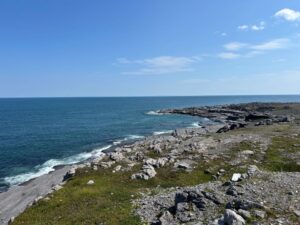
The limestone barrens of Cape Norman, located on the tip of Newfoundland’s Great Northern Peninsula.
Vast, windswept, and rocky— Newfoundland’s limestone barrens can feel like you’re on the edge of the world. The soil is thin, the winds relentless, and the climate unforgiving. At first glance, it appears barren and inhospitable —a place where little could possibly grow. But look a little closer, and you’ll see that life has indeed found a foothold. Thanks to thousands of years of adaptation to this challenging environment, life is both incredibly resilient and surprisingly diverse.
Limestone Barrens of Newfoundland’s Great Northern Peninsula
Although limestone is a widely distributed sedimentary rock, limestone barrens habitats are globally rare. In Canada, they are found in western Newfoundland and, in small quantities, in southern Labrador. On the island of Newfoundland, limestone barrens cover less than 1% of the land area, primarily along the coast of Newfoundland’s Great Northern Peninsula. The landscape is defined by exposed rock surfaces, angular boulders, thin layers of gravel, and shallow soil. Habitat types range from sparsely vegetated rock and gravel barrens to bedrock completely blanketed with crowberry.
The limestone of western Newfoundland was deposited between 520 and 460 million years ago, when the region was submerged beneath a warm, shallow marine environment. Overtime, periods of large-scale tectonic movement and glacial action ultimately formed the limestone deposits we see today.
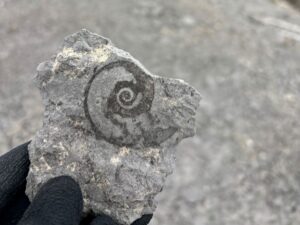
Fossil of an ancient gastropod on the limestone barrens in Port au Choix, NL.
True Newfoundlanders
The plants of the limestone barrens are true Newfoundlanders, remaining resilient even in the toughest conditions. To survive here, they must withstand nutrient-poor soils, soil erosion, low temperatures, strong winds, and a relatively short growing season. These hardy plants possess unique adaptations that allow them to thrive under harsh conditions, including growing low to the ground to withstand wind and rain, developing dark coloured leaves that absorb more heat, forming cushion-like growth to collect and conserve water, growing woolly coverings on stems that help retain heat, and producing cup-shaped flowers that rotate to face the sun and maximize sunlight.
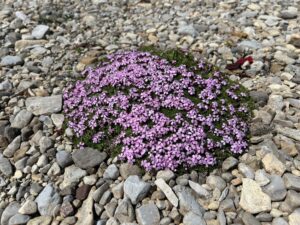
One of the first flowers to bloom on the limestone barrens in the spring, moss campion (Silene acaulis) is a low-growing, mat-forming plant, pictured in Sandy Cove, NL.
Tiny Plants Standing up to Big Forces
Limestone gravel is an unstable home, with plants frequently subjected to natural disturbances like freeze-thaw cycles and frost sorting.
These critical processes churn limestone gravel, sorting soil particles and rocks into intricate patterns creating a dynamic, ever-changing landscape. The upward movement of material scan dislodge shallow-rooted plants, inhibiting competitors, and creating open spaces ideal for opportunistic arctic-alpine species. To survive, some plants develop deep root systems that can reach meters down through cracks and crevices, anchoring them against the shifting terrain. It’s a fragile balance—and one your support helps safeguard.
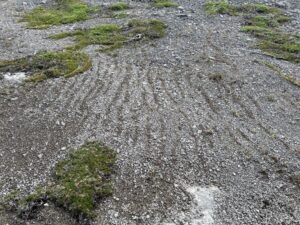
Frost sorting separates fine sediment from larger stones, creating unique patterns on the limestone barrens. These sorted stripes can be seen in Port au Choix, NL.
A Biodiversity Hotspot
Although climate and soil seem to conspire against life on the limestone barrens of Newfoundland’s Great Northern Peninsula, this ecosystem is a biodiversity hotspot and home to a plethora of rare plants. Four plant species of the limestone barrens are listed under the federal Species at Risk Act, while six are listed under the provincial Endangered Species Act. Three of these species are endemic, meaning they are found nowhere else on Earth: Fernald’s braya (Braya fernaldii), Long’s braya (Braya longii), and Barrens willow (Salixjejuna). These rank among the rarest plants in the world. The distribution of Long’s braya is restricted to a narrow coastal strip of limestone barrens habitat on the Northern Peninsula, spanning just 26 kilometres.

A small but mighty Fernald’s Braya on the limestone barrens in Yankee Point, NL.
A Shared Commitment to Safeguard a Fragile Ecosystem
Newfoundland’s limestone barrens have experienced significant degradation over time—from quarrying for construction materials to other human disturbances. Our team is dedicated to protecting this critical habitat and restoring the rare, endangered plants that depend on it.
The Wilder Institute is proud to collaborate with Memorial University of Newfoundland, Intervale Associates, the Stewardship Association of Municipalities, the Government of Canada, and the Government of Newfoundland and Labrador. Together, we’re fostering a culture of stewardship—encouraging responsible use of the limestone barrens that honours both cultural traditions and ecological balance. By working alongside local communities, we aim to preserve this rare ecosystem for generations to come.
Join us. Learn more about our work and help protect Canada’s most at-risk ecosystems by supporting the Wilder Institute’s conservation programs.
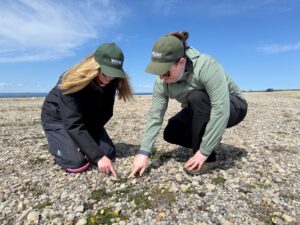
Wilder Institute employees during 2025 restoration in Sandy Cove, NL.
